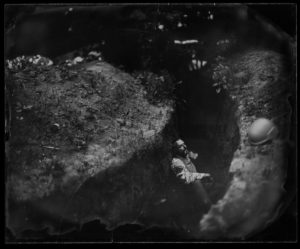There are lots of good photojournalists working today. In particular, war photographers have a more difficult job than most, going into active war zones to cover how the conflict is progressing and how the lives of those caught in the middle have changed. And today, there are few places to get work as a war photographer quite like Ukraine. However, Soviet-born Israeli photographer Edward Kaprov stands out for using old techniques on modern subjects. Kaprov uses one of the oldest forms of photography, the wet plate collodion method. It involves taking collodion, or nitrocellulose dissolved into alcohol and ether, and pouring it over aluminum or glass plates. Those plates get dipped into silver nitrate, creating a photosensitive surface. The photographer exposes the plate to the light while still wet, then treats it with water and several other chemicals, creating a black-and-white impression known as tintypes when on aluminum or ambrotypes when on glass. Because you must take the photo while the plates are still wet, this process must happen very quickly. For photographers who want to work outdoors, this requires them to build portable darkrooms. Kaprov has been drawn to borderlands for much of his career. His work has taken him from Israel to Chechnya and now Ukraine.
This is not the first time wet plate collodion photography has been used to document a conflict in Ukraine. In 1854, the British photographer Roger Fenton became one of the first noteworthy war photographers when his battlefield pictures of the Crimean War circulated among British newspapers. Fenton converted a horse-drawn wagon into a studio to develop his pictures in the field, resulting in works like The Valley of the Shadow of Death taken in the aftermath of the Siege of Sevastopol. Following in Fenton’s footsteps, Kaprov has his mobile darkroom, using a converted Ford Transit instead of a wagon. Not long after Russian troops crossed the border into Ukraine, Kaprov loaded it up with about a hundred glass plates and over six hundred fifty pounds of chemicals and water. While a good deal of contemporary war photography tries to catch combatants in the moment of action, Kaprov’s preferred medium does not allow that. His subjects must stand completely still while the plate captures the image. These photos’ color and quality make it look like they were taken on the First World War’s Eastern Front. His landscape pictures of felled birch trees have the same aura as those taken in the Argonne Forest in 1915. A viewer could easily mistake the still moments of soldiers for shots taken during the Russian Civil War if it weren’t for the modern firearms. Kaprov noted that it is the signs of modern life combined with the older medium that he wishes to make viewers look twice. “I want to confuse the audience, […] I want the act of comparing them with past wars, because in fact nothing has changed. Maybe the weapons and cellphones have changed, but the essence of war does not change.” By using the same method in the same place as Fenton, Kaprov to some extent consciously repeats this cycle.
Because of the relatively lengthy process of setting up the box camera, taking a photograph, then rushing back to the van to have it developed, there’s an intimacy to Kaprov’s photographs that not many photojournalists in Ukraine have been able to capture. It’s not simply the intimacy between the subject and the viewer but between the subject and the artist. In documentary footage, Kaprov often converses with his subjects and gets to know them, asking about their experience before and during the war. Kaprov also uses his van to transport supplies and people if needed. He said to ARTE.tv, “I don’t think photography can end the war. It gives me an excuse to stay close to these people and do everything to help them, with pain and compassion.” The photographs are therefore more personal, especially with the context. But with Kaprov, there is also a personal connection. Though he was born and raised in the Russian city of Chelyabinsk, less than 90 miles from the border with Kazakhstan, Kaprov’s grandparents were all from Ukraine. All four were from Zhytomyr, a city 90 miles west of Kyiv that sustained some damage from Russian airstrikes in the early days of the invasion in March 2022.
Anyone who studies the past can tell you that history is seldom linear, but it is often cyclical. Kaprov’s message can be interpreted as a depressing reminder that war and conflict will continue to plague us even if everything else changes. But the perceived anachronism between the medium and Kaprov’s subjects is so striking that it breathes new life into issues that many have grown weary of hearing about.

